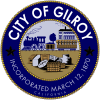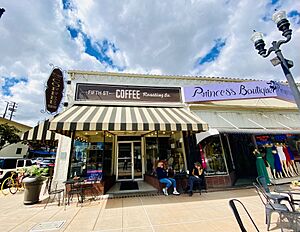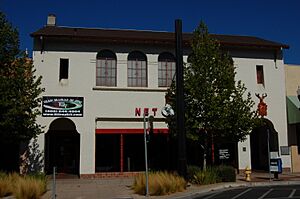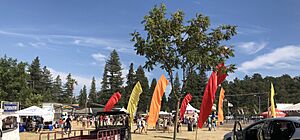Gilroy, California facts for kids
Quick facts for kids
Gilroy, California
|
|||
|---|---|---|---|
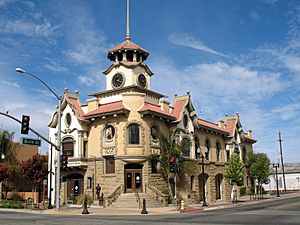
Old City Hall in Downtown Gilroy
|
|||
|
|||
| Nickname(s):
"Garlic Capital of the World"
|
|||
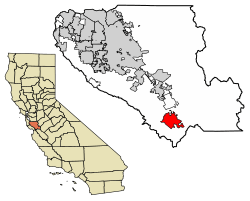
Location of Gilroy in Santa Clara County, California
|
|||
| Country | United States | ||
| State | California | ||
| County | Santa Clara | ||
| CSA | San Jose-San Francisco-Oakland | ||
| Metro | San Jose-Sunnyvale-Santa Clara | ||
| Incorporated | March 12, 1870 | ||
| Named for | John Gilroy | ||
| Area | |||
| • City | 16.52 sq mi (42.78 km2) | ||
| • Land | 16.51 sq mi (42.75 km2) | ||
| • Water | 0.01 sq mi (0.03 km2) 0.06% | ||
| • Metro | 2,695 sq mi (6,979 km2) | ||
| Elevation | 200 ft (61 m) | ||
| Population
(2020)
|
|||
| • City | 59,520 | ||
| • Estimate
(2021)
|
58,101 | ||
| • Density | 3,576.18/sq mi (1,380.75/km2) | ||
| • Metro | 1,836,911 | ||
| • Metro density | 681.70/sq mi (263.205/km2) | ||
| Demonym(s) | Gilroyan | ||
| Time zone | UTC−8 (Pacific Time Zone) | ||
| • Summer (DST) | UTC−7 (PDT) | ||
| ZIP codes |
95020, 95021
|
||
| Area code | 408/669 | ||
| FIPS code | 06-29504 | ||
| GNIS feature IDs | 277523, 2410591 | ||
Gilroy is a city in Santa Clara County, California, United States. It is located south of the San Francisco Bay Area. In 2020, about 59,520 people lived there.
Gilroy started as a small village called San Ysidro in the early 1800s. This land was given to a rancher named Ygnacio Ortega in 1809. After he passed away, his daughter Clara and her husband, John Gilroy, took over most of the land. They began to develop the area.
In 1868, the town became official and was named after John Gilroy. He was a Scotsman who came to California in 1814. To own land in the Spanish Empire, he became a Mexican citizen, learned Spanish, and became Catholic. He then took the name Juan Bautista Gilroy.
Gilroy is famous for its garlic farms. It is even called the "Garlic Capital of the World"! The city is also known for its small, special wineries. These are mostly family-owned vineyards near the Santa Cruz Mountains.
Contents
- Gilroy's Past: A Journey Through Time
- Gilroy's Location and Weather
- People of Gilroy: Demographics and Growth
- Gilroy's Economy and Jobs
- Fun and Culture in Gilroy
- Parks and Recreation in Gilroy
- Education in Gilroy
- Media in Gilroy
- Getting Around Gilroy: Transportation
- Gilroy's Sister Cities
- Famous People from Gilroy
- Images for kids
- See also
Gilroy's Past: A Journey Through Time
Spanish Era: Early Explorers and Settlements
Spanish explorers first arrived in the Santa Clara Valley in 1776. This group was led by Juan Bautista de Anza. About 20 years later, Spanish missionaries built Mission San Juan Bautista in 1797. It was located near the Pajaro River.
In 1809, a large piece of land called Rancho San Ysidro was given to Ygnacio Ortega. It was about 13,066 acres (5,288 hectares). The village of San Ysidro grew near this rancho. It was at the foot of Pacheco Pass. This pass connected the El Camino Real (a main road) with the San Joaquin Valley. Back then, California mostly traded animal hides and fat. These were shipped to other parts of New Spain. Trading with foreigners was not allowed, but people still did it quietly to get fancy goods.
Mexican Era: John Gilroy's Story
During the War of 1812, a British ship called the Isaac Todd sailed to California. It stopped in Monterey, California in 1814. John Gilroy, a sailor from Scotland, was on this ship. He had changed his name from John Cameron to avoid being recognized. He either left the ship or was left behind because he was sick.
John Gilroy (1794–1869) became known as Juan Bautista Gilroy. For several years, he traveled between the missions, towns, and ranchos. He worked as a cooper, making barrels. He was one of the first two English-speakers in Alta California. He eventually settled at Rancho San Ysidro. He became Catholic and was the first English-speaking settler to become a Mexican citizen in Alta California.
In 1821, Mexico became independent from Spain. That same year, John Gilroy married Maria Clara, the daughter of his employer, Ygnacio Ortega. When Ygnacio died in 1833, his rancho was divided among his three children, including Maria Clara. In 1867, John Gilroy officially received the land under U.S. law.
The area now called "Old Gilroy" grew around Gilroy's rancho. After the Mexican–American War ended in 1848, Gilroy served as the mayor of the village. It was also a stop for stagecoaches in the late 1800s.
American Era: Growth and Garlic
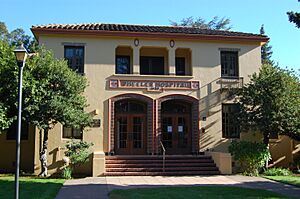
After the U.S. took over California and gold was found in 1848, many people moved to the area. Mexican landowners often sold their land or lost it. The area around San Ysidro became known as Pleasant Valley. On March 12, 1870, the state officially made it the town of Gilroy. John Gilroy had passed away in 1869. By then, the town center had moved west of the old main road.
Raising cattle and cutting timber from the Santa Cruz Mountains were important jobs. But farming became the biggest source of money for the town. In the 1920s, Kiyoshi “Jimmy” Hirasaki started growing garlic for sale in Gilroy. He was known as the "Garlic King."
In 1979, the Gilroy Garlic Festival began. Farming is still important, but since the 1970s, Gilroy has also become a place where people live and commute to work in Silicon Valley.
There are many old buildings in Gilroy. The Christian Church at 160 Fifth Street was built in 1857. It is the oldest wooden church in Santa Clara County that is still used. George Eustice's house at 213 Fifth Street was built in 1869. He was a blacksmith and fought in the American Civil War. Samuel Moore, a long-time postmaster, built his home in the 1870s at 7151 Church Street.
Nearby, in the Diablo Range foothills, is the historic Gilroy Yamato Hot Springs. It was first developed in the 1870s but is now closed. In 1905, the Old City Hall was built downtown. It was added to the National Register of Historic Places in 1975.
Gilroy's Location and Weather

Gilroy covers about 16.2 square miles (42 square kilometers). Most of this is land.
Climate: Warm Summers and Mild Winters
Gilroy has a warm Mediterranean climate. This means it has hot, dry summers and mild, wet winters. The nearby Pacific Ocean helps keep temperatures from getting too extreme.
In summer, the average high temperature is about 90°F (32°C). In winter, the average low is around 34°F (1°C). It rains about 19 inches (480 mm) per year, mostly in winter. Snow is very rare, happening only about once every 20 years.
In summer, fog often rolls in from the ocean around 10 p.m. and clears by 10 a.m. the next morning. Gilroy can get hotter than areas to its north and west during summer afternoons. Winters have many sunny days with breaks between rainstorms. The area does not often have tornadoes, strong winds, or thunderstorms. The local plants are mostly chaparral and grasslands, with live oak trees in higher areas.
The hottest day ever recorded was 115°F (46°C) on July 15, 1972. The coldest was 17°F (-8°C) in December 1990.
| Climate data for Gilroy, California (1991–2020 averages, extremes 1957–present) | |||||||||||||
|---|---|---|---|---|---|---|---|---|---|---|---|---|---|
| Month | Jan | Feb | Mar | Apr | May | Jun | Jul | Aug | Sep | Oct | Nov | Dec | Year |
| Record high °F (°C) | 80 (27) |
86 (30) |
90 (32) |
100 (38) |
106 (41) |
112 (44) |
115 (46) |
112 (44) |
113 (45) |
107 (42) |
94 (34) |
80 (27) |
115 (46) |
| Mean maximum °F (°C) | 71.2 (21.8) |
76.4 (24.7) |
81.9 (27.7) |
89.0 (31.7) |
94.1 (34.5) |
100.1 (37.8) |
101.6 (38.7) |
102.1 (38.9) |
101.0 (38.3) |
95.3 (35.2) |
82.9 (28.3) |
70.5 (21.4) |
105.6 (40.9) |
| Mean daily maximum °F (°C) | 60.7 (15.9) |
64.0 (17.8) |
68.1 (20.1) |
71.9 (22.2) |
77.3 (25.2) |
82.8 (28.2) |
87.2 (30.7) |
87.2 (30.7) |
84.9 (29.4) |
78.8 (26.0) |
68.3 (20.2) |
60.4 (15.8) |
74.3 (23.5) |
| Daily mean °F (°C) | 49.4 (9.7) |
52.2 (11.2) |
55.3 (12.9) |
58.2 (14.6) |
63.1 (17.3) |
67.2 (19.6) |
70.6 (21.4) |
70.8 (21.6) |
68.7 (20.4) |
63.4 (17.4) |
55.0 (12.8) |
48.7 (9.3) |
60.2 (15.7) |
| Mean daily minimum °F (°C) | 38.1 (3.4) |
40.4 (4.7) |
42.6 (5.9) |
44.5 (6.9) |
49.0 (9.4) |
51.6 (10.9) |
54.0 (12.2) |
54.4 (12.4) |
52.5 (11.4) |
47.9 (8.8) |
41.6 (5.3) |
37.0 (2.8) |
46.1 (7.8) |
| Mean minimum °F (°C) | 28.4 (−2.0) |
32.4 (0.2) |
35.0 (1.7) |
37.6 (3.1) |
42.8 (6.0) |
45.7 (7.6) |
50.0 (10.0) |
49.7 (9.8) |
46.0 (7.8) |
40.3 (4.6) |
32.7 (0.4) |
28.2 (−2.1) |
26.0 (−3.3) |
| Record low °F (°C) | 18 (−8) |
23 (−5) |
23 (−5) |
27 (−3) |
31 (−1) |
36 (2) |
41 (5) |
37 (3) |
30 (−1) |
29 (−2) |
23 (−5) |
17 (−8) |
17 (−8) |
| Average precipitation inches (mm) | 4.55 (116) |
4.27 (108) |
2.59 (66) |
1.30 (33) |
0.56 (14) |
0.15 (3.8) |
0.00 (0.00) |
0.03 (0.76) |
0.04 (1.0) |
0.85 (22) |
1.74 (44) |
3.69 (94) |
19.77 (502) |
| Average precipitation days (≥ 0.01 in) | 9.8 | 9.8 | 7.8 | 5.1 | 2.5 | 0.6 | 0.3 | 0.3 | 0.6 | 2.8 | 6.1 | 9.3 | 55.0 |
| Source: NOAA | |||||||||||||
People of Gilroy: Demographics and Growth
| Historical population | |||
|---|---|---|---|
| Census | Pop. | %± | |
| 1870 | 1,625 | — | |
| 1880 | 1,621 | −0.2% | |
| 1890 | 1,694 | 4.5% | |
| 1900 | 1,820 | 7.4% | |
| 1910 | 2,437 | 33.9% | |
| 1920 | 2,862 | 17.4% | |
| 1930 | 3,502 | 22.4% | |
| 1940 | 3,615 | 3.2% | |
| 1950 | 4,951 | 37.0% | |
| 1960 | 7,348 | 48.4% | |
| 1970 | 12,684 | 72.6% | |
| 1980 | 21,641 | 70.6% | |
| 1990 | 31,487 | 45.5% | |
| 2000 | 41,464 | 31.7% | |
| 2010 | 48,821 | 17.7% | |
| 2020 | 59,520 | 21.9% | |
| 2023 (est.) | 58,520 | 19.9% | |
| U.S. Decennial Census | |||
Population in 2000
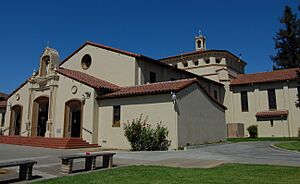
In 2000, Gilroy had 41,464 people living in 11,869 households. About 47.7% of households had children under 18. Most households (60.8%) were married couples. The average household had 3.46 people.
The population was quite young, with 32.6% under 18. The median age was 30 years old. For every 100 females, there were about 99 males.
The average income for a household was $66,401. For families, it was $80,371. About 10.4% of the population lived below the poverty line.
Population in 2010
By 2010, Gilroy's population grew to 48,821. The city had 14,175 households. About 50.2% of these had children under 18. Most people (98.3%) lived in regular homes.
The population was still young, with 30.7% under 18. The median age was 32.4 years. For every 100 females, there were about 98.5 males.
Most homes (60.8%) were owned by the people living in them. The rest (39.2%) were rented.
Population in 2020
In 2020, Gilroy's population reached 59,520 people. There were 17,023 households. This makes up about 3% of Santa Clara County's population.
The city is very diverse:
- 58.3% Hispanic or Latino
- 26.7% Caucasian
- 9.9% Asian
- 1.8% African American
- 0.5% Native American
- 19.8% from two or more races
The average household income was $116,206. The average cost of a home was $778,300.
Gilroy's Economy and Jobs
Gilroy is part of the Santa Clara Valley AVA. This is a special area for wineries and vineyards. It includes Gilroy, Saratoga, San Martin, and Morgan Hill.
Major Employers in Gilroy
The top five employers in Gilroy are:
- Gilroy Unified School District (schools)
- Christopher Ranch LLC (garlic company)
- Saint Louise Regional Hospital
- Walmart
- Olam International (food and agriculture company)
Fun and Culture in Gilroy
Annual Events and Festivals
Gilroy hosts several fun events each year:
- Gilroy Rodeo
- Tamal Festival
- Gilroy Garlic Festival (ended in 2022)
Gilroy also has over 20 wineries. You can visit their tasting rooms along the Santa Clara Valley Wine Trail.
Public Library
The Santa Clara County Library District runs the Gilroy Library. It's a great place to find books and learn new things.
Parks and Recreation in Gilroy
Gilroy has several places for outdoor fun:
- Gilroy Gardens: An amusement park with rides and gardens.
- Christmas Hill Park: Has a playground, bike trails, and sports fields.
- Gilroy Sports Park: Also features a playground, sports fields, and bike trails.
Education in Gilroy
Public Schools and College
The Gilroy Unified School District manages the public schools. There are:
- Seven elementary schools
- Three middle schools
- Three high schools
Gilroy is also home to Gavilan College, a local college.
Private Schools
- St. Mary's School
- Pacific Point Christian School
Charter School
- Gilroy Prep School
Media in Gilroy
The city has a local newspaper called Gilroy Dispatch. It is a weekly newspaper that started in 1868.
CMAP TV is a community TV internet channel.
Radio stations in the area include:
- KBAY (94.5 FM), based in Gilroy
- KAZA (1290 AM)
Getting Around Gilroy: Transportation
Airports
For small planes, there's San Martin Airport (E16). It's about six miles north of Gilroy. For bigger commercial flights, people use San Jose International Airport. It's about 36 miles (58 km) away in San Jose.
Major Highways
Gilroy is served by two main highways:
Public Transportation Options

- The Santa Clara Valley Transportation Authority offers local buses. They also have express buses to San Jose and Sunnyvale.
- Gilroy is the last stop for Caltrain. This train runs during busy hours on weekdays. It connects Gilroy to the Santa Clara Valley, the San Francisco Peninsula, and San Francisco.
- Amtrak California's Capitol Corridor train will eventually stop at the Gilroy station.
- Monterey-Salinas Transit's Line 55 is a bus that goes between San Jose and Monterey during busy hours. It also connects to Amtrak.
- San Benito County Express provides bus service to Hollister and San Juan Bautista.
Gilroy's Sister Cities
Gilroy has "sister city" relationships with several cities around the world:
Famous People from Gilroy
- George Washington Kirk (1837–1905), a Union Colonel in the American Civil War.
- Gene Hildebrand (1887–1921), a US national champion jockey.
- Ivie Anderson (1904–1949), a jazz singer.
- Charles Gubser (1916–2011), a US Representative from California (1953–1974).
- Reginald B. Desiderio (1918–1950), a US Medal of Honor winner.
- John Hudson (1919–1996), an actor.
- William Hudson (1919–1974), an actor.
- Kevin A. Gilroy (1936–2013), a US Air Force colonel and mayor of Gilroy (1997–1999).
- Olga Talamante (born 1950), a Chicana political activist.
- Maryedith Burrell (born 1952), a film and television producer.
- Jeff Garcia (born 1970), a football quarterback.
- Daniel Cormier (born 1979), a mixed martial artist and UFC commentator.
- Chris Gimenez (born 1982), a professional baseball player.
- Robert Guerrero (born 1983), a professional boxer.
- Jesse Delgado (born 1992), a mixed martial artist and wrestler.
- Dustin Wolf (born 2001), a professional hockey player.
Images for kids
See also
 In Spanish: Gilroy (California) para niños
In Spanish: Gilroy (California) para niños



